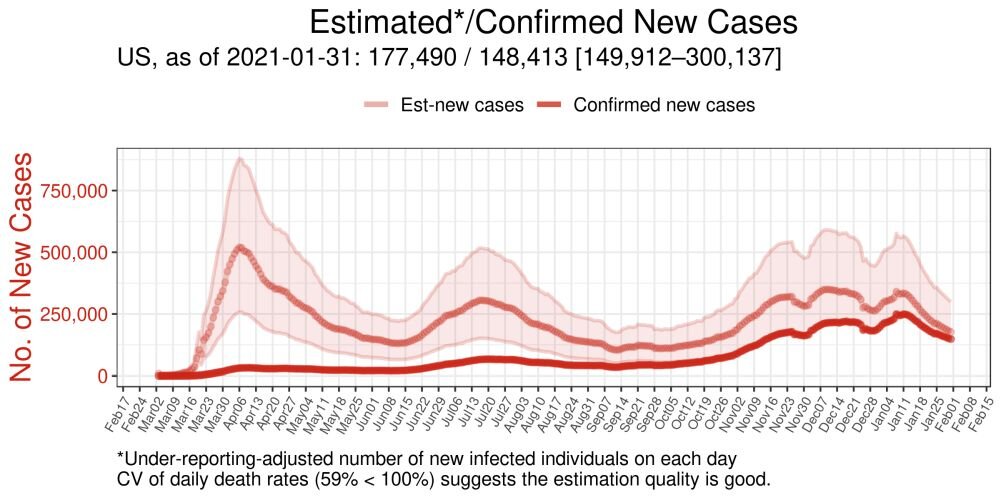
Plot representing adjusted underreporting of new daily cases Credit: Images from Jungsik Noh via GitHub (https://github.com/JungsikNoh/COVID19_Estimated-Size-of-Infectious-Population) (CC-BY 4.0, creativecommons.org/licenses/ by / 4.0 /)
A new machine learning framework uses reported test results and mortality rates to calculate estimates of the actual number of current COVID-19 infections in all 50 U.S. states and 50 countries. Jungsik Noh and Gaudenz Danuser, from the Southwestern Medical Center at the University of Texas, present these findings in the open access journal PLOS ONE on February 8, 2021.
During the ongoing pandemic, US states and many countries reported daily counts of COVID-19 infections and deaths confirmed by tests. However, many infections were not detected, resulting in an insufficient count of the total number of people currently infected at any given time – an important metric to guide public health efforts.
Now, Noh and Danuser have developed a computational model that uses machine learning strategies to estimate the actual daily number of current infections for all 50 U.S. states and the 50 most infected countries. To make the calculations, the model is based on previously published pandemic parameters and daily publicly available data on confirmed cases and deaths. Views of these daily estimates are available for free online.
The model’s estimates indicate a serious underestimation of cases in the United States and worldwide. The cumulative number of real cases in 9 out of 50 countries is estimated to be at least five times higher than confirmed cases. In the US, estimates of the cumulative number of actual cases within the states were in line with the results of an antibody test study conducted in 46 states.

Graph representing estimated active cases for the USA. Credit: Jungsik Noh images via GitHub (https://github.com/JungsikNoh/COVID19_Estimated-Size-of-Infectious-Population) (CC-BY 4.0, creativecommons.org/licenses/by /4.0/)
For some countries, such as the United States, Belgium and the United Kingdom, estimates indicate that more than 20% of the total population has had an infection. As of January 31, 2021, some states in the United States – including Pennsylvania, Arizona and Florida – had active cases, totaling more than 5 percent of the state’s entire population. In Washington, active cases were estimated at 1% of the population that day.
Looking ahead, the model has estimated the current COVID-19 case count within communities, which can help inform contact tracking and other public health efforts.
The authors add: “Given that confirmed cases only capture the tip of the iceberg in the middle of the pandemic, the estimated sizes of current infections in this study provide crucial information to determine the regional severity of COVID-19 that can be misguided by confirmed cases. . ”
Follow the latest news on the coronavirus outbreak (COVID-19)
Noh J, Danuser G (2021) Estimated fraction of people infected with COVID-19 in the US states and countries around the world. PLoS ONE 16 (2): e0246772.
doi.org/10.1371/journal.pone.0246772
Supplied by Public Library of Science
Quote: Serious underestimation of COVID-19 cases in the USA, other countries estimated via model (2021, February 8) retrieved on February 9, 2021 at https://medicalxpress.com/news/2021-02-severe-undercounting-covid -cases-countries .html
This document is subject to copyright. In addition to any fair dealing for the purpose of study or private research, no part may be reproduced without written permission. The content is provided for informational purposes only.
